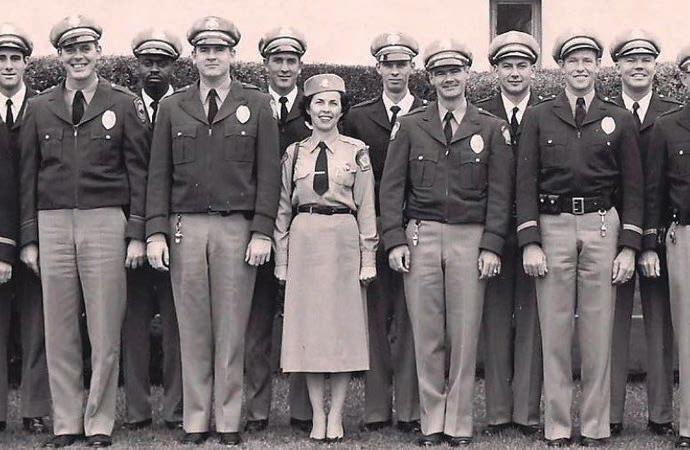
5 minute read
Celebrating Women's History Month: Coronado's First Policewomen
1956 was an exciting year for Coronado’s police force. In January, the department announced the first full-time policewoman, Mrs. Betty Frances Walters. The appointment was the result of then Chief Robert Manchester’s request that the position of clerk be changed to that of policewoman. A few months prior, at the end of 1955, the City Council approved the position. In a Coronado Journal job advertisement, the post qualifications included “age, 23-35; minimum height, 5 feet 5 inches,” in addition to educational background and experience. The position of a policewoman was to include duties such as “clerical work, criminal investigation and enforcement and that she will deal with cases involving women and children.”
Alice Stebbins Wells of the Los Angeles Police Department is widely credited as being one of America’s first “policewomen” in 1910. The Los Angeles Herald explained that women were needed in enforcement in order “to inspect dance halls and such other places where young girls congregate and where they are especially in need of police protection.” While policewomen started to be accepted into service at that time, they could “ wear a star,” but they were not expected to “juggle a baton.” For that reason, a policewoman’s salary of 73% of a policeman’s salary was seemingly justified.
Locally, women have served the San Diego Police Department since 1909, according to the San Diego Police Historical Association. Rose Longacre was SDPD’s first female employee, hired to serve as a “matron.” Towards the end of the 19th century, matrons were often wives of law enforcement officers who oversaw temporary holding cells. Matrons were charged with searching female suspects, helping with lost children, cleaning cells, and mending clothes. Matron duties were often seen as an extension of the husband’s service and were not always compensated positions. As law enforcement departments developed into the 20th century, many of the matron positions became paid positions and later were exchanged for clerical positions.

Coronado had several matrons in the first half of the 20th century. While the names of most of the police matrons who served Coronado have been lost to history, a few are known. Kate Burrows was appointed police matron on petition by Police Chief Smith in 1933. Nellie B. Taylor began serving as a police matron in 1946. When interviewed about her position by the Coronado Journal she stated that the most interesting experience she ever had was “my first call for duty with the police department” but would not elaborate as she firmly held to the police force’s confidential oath.
Coronado’s first official policewoman, Betty Walters, came to Coronado in 1956 with experience as a member of the police force in Cincinnati, Ohio. The Coronado Journal explained that her qualifications, as well as her determination, got her the job: “Mrs. Walters, a native of Illinois, headed the list of applicants in scores on a recent Civil Service examination for the post...She flew here at her own expense for an oral interview with the city manager, the chief of police, and the chairman of the Civil Service Commission. She was their unanimous choice.” In addition to her previous experience, Walters was also trained in the unarmed martial art of Judo. Walters only served Coronado for seven months before moving on to a post in Chula Vista.
The post wasn’t left open for long. Marianne Cavanaugh, a Coronado local, was appointed to fill the role. Cavanaugh was photographed for the front page of the Coronado Journal for their report on the “great shoe mystery.” Over the span of two years, several women reported burglary and theft of their high-heeled shoes. Most interestingly, the shoe burglar threw away one from each pair of shoes, leaving them all over town. As the Journal explained, “the others have been turning up all over town—one in Dr. Lahmann’s garden, two at the football field, others on Adella, A avenue, Eighth street, and G avenue. Most of them are left shoes.” Policewoman Cavanaugh was on hand to collect the evidence and review it at department headquarters. The burglar was later caught and charged with several counts.

Mrs. Cavanaugh left the force in 1958 and was replaced by another Coronado local, Marceline Matlock. Matlock had graduated two years prior from the San Diego Police Academy. She is assumed to be the unnamed woman in the San Diego Police Academy photo above, taken in 1956. She was the only woman among thirty-five men who graduated. She served as clerk of Coronado’s Judicial Court for many years following.
As the Coronado Historical Association delves more into women’s history in the police force, the public is encouraged to submit any photographs or information they have relating to this topic to info@coronadohistory.org.










